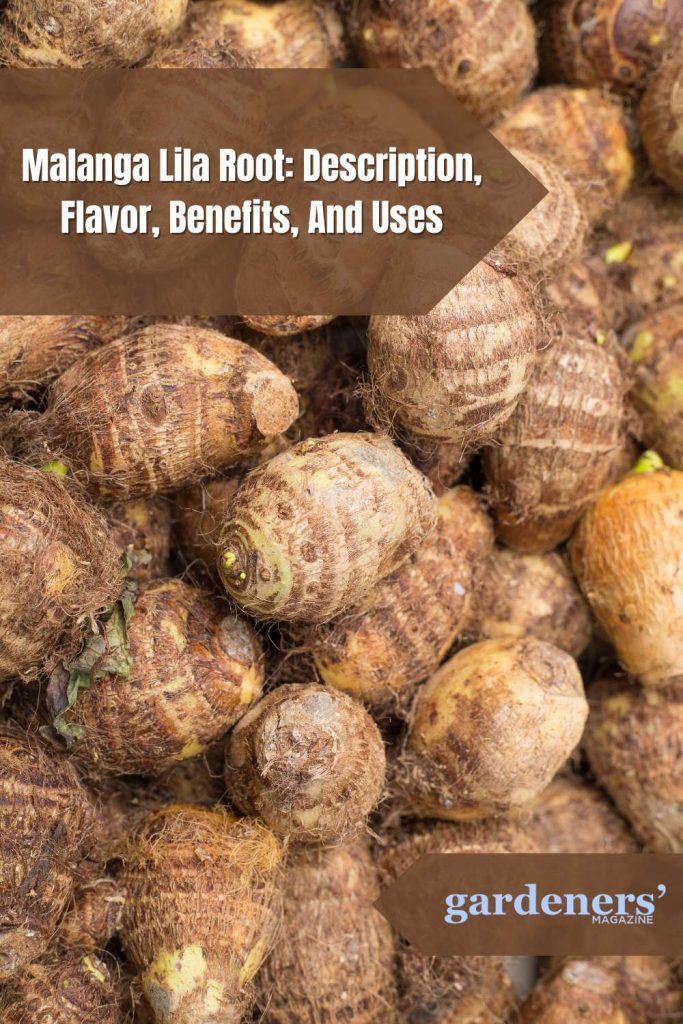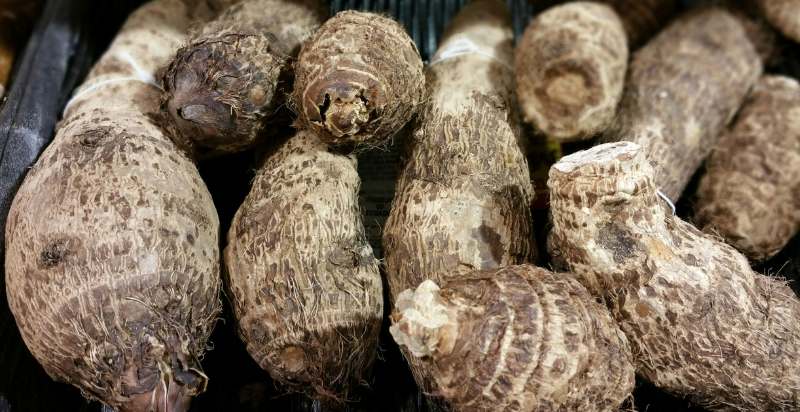Malanga Lila Root is a root vegetable native to Central and South America. It’s an edible member of the Araceae family and belongs to the same subfamily as the taro root, Xanthosoma sagittifolium. Also known as yautia or tannia, Malanga Lila Root has been cultivated by indigenous peoples for centuries and is still popular in Latin American cuisine. Here is everything you need to know about Malanga Lila Root.
What is Malanga Lila Root?
Malanga Lila root is a tropical tuber native to South and Central America. It is an ancient crop grown and consumed for centuries, providing numerous health benefits. The plant looks similar to a small sweet potato but has a brownish-black coloration on the outside. Its interior is white and starchy, with a slightly nutty flavor.
The root is also a great dietary fiber, iron, potassium, and magnesium source. As such, it has been used for centuries as food and medicine in South American cultures. It can be cooked like potatoes or boiled to make soups and stews. The ground powder made from dried Malanga Lila root can also be added to smoothies or drinks for added health benefits. It is becoming increasingly popular in the United States as a healthy source of carbohydrates and fiber.

History and Origin of Malanga Lila Root
Malanga Lila (Xanthosoma sagittifolium) root is a popular vegetable native to Central and South America. It has been an important part of the traditional cuisine in many countries, including Colombia, Peru, Puerto Rico, and Cuba, for hundreds of years. It is also commonly known by other names such as tannia, yautia, pakchoi, and tanier.Malanga Lila root has a long history that goes back to the Aztecs, who used the vegetable in various ways. The plant leaves were used as an herbal remedy for fever, headaches, and stomach aches.
Today, Malanga Lila root is gaining popularity in other parts of the world due to its nutritional benefits and versatility in recipes. It is an excellent source of dietary fiber and can help lower cholesterol levels as well as aid digestion. The root can also be used to make healthy snacks like chips, fries, and even desserts.
Description of the Malanga Lila Root
The Malanga Lila root is a versatile vegetable. It has light purple-tinged skin ranging in size from 2 to 5 cm in diameter and can be found cylindrical or conical. Inside, the flesh is white and starchy with a pleasantly sweet flavor. The tuberous root can be boiled, fried, or mashed for an array of dishes.
Flavor Profile of Malanga Lila Root
Malanga Lila Root has a unique flavor profile characterized by its nutty, earthy taste with hints of sweetness. It has a pleasant aroma and texture, making it an ideal ingredient for many dishes. The root can be boiled, fried, mashed, or roasted to bring out the full flavor.
Cultivation of the Malanga Lila Root
Malanga Lila root is a tropical tuber crop that can be cultivated in various soils, from sandy to clayey. It requires well-drained soil with good fertility and organic matter content for optimal growth and yields. The ideal soil pH should be between 5.5 and 6.5.
The best time to cultivate malanga lila root is during the rainy season when the soil has sufficient moisture. Planting can begin as early as April, depending on prevailing conditions in each location. The tubers should be planted at a depth of 10 cm and spaced 25–30 cm apart, with rows spaced 60–90 cm apart.
The crop takes around four months to reach maturity, which may vary depending on the variety and growing conditions. After harvesting, the tubers must be cured for two to three days in a dry place with good ventilation and then stored in a cool, dark place or refrigerated.
Harvesting of the Malanga Lila Root
Malanga Lila root can be harvested from plants between two and five years old. After a few months of growth, the plant should have developed a long, thick stem with abundant leaves. At this stage, the malanga lila root can be harvested by carefully digging down around the base of the plant and gently lifting it to remove the root. The root should be washed, dried, and peeled before being used. It may then be cooked or stored for later use.
What are the Health Benefits of the Malanga Lila Root?
Malanga Lila root is a nutrient-dense food source that provides many essential vitamins and minerals. It is a good source of dietary fiber, antioxidants, iron, calcium, magnesium, phosphorus, potassium, zinc, copper, manganese, and B vitamins such as folate. The tuber is also packed with heart-healthy fats and protein.
Some studies suggest that consuming malanga lila root may help reduce cholesterol and inflammation and improve digestive health. Additionally, it may have potential anti-diabetic benefits due to its high fiber content. Finally, for generations, malanga lila root has been used in traditional medical systems to treat various ailments.
Where Does Malanga Lila Root Grow?
Malanga Lila root is widely grown in tropical regions of the Americas, particularly in Mexico, Central America, and parts of South America. It is also found in the Caribbean, Africa, and India. In the United States, malanga lila grows wild from Texas to Florida.
In addition to warm climates where it is grown commercially or in home gardens, malanga lila is known to grow as an ornamental plant in colder climates. It can even survive light frosts. While this root crop is most popular and readily available in Latin American countries, it can also be found in some American supermarkets and specialty food stores.
Where can the Best Quality Malanga Lila Root be found?
The best quality Malanga Lila Root can be found online through specialty retailers. Some popular online retailers that carry Malanga Lila Root include Amazon, Walmart, iHerb, and Vitacost. Finding high-quality Malanga Lila Root in some international health food stores or Latin American grocery stores is also possible.
However, when purchasing from these stores, it is important to ensure that the product is fresh and has not been sitting on shelves for too long. Additionally, some farmer’s markets may offer Malanga Lila Root seasonally. When shopping at a farmer’s market, it is best to look for vendors who specialize in root vegetables or organic produce.
What are the things you need to keep in mind when buying Malanga Lila Root?
- Choose a reputable vendor: Make sure to purchase Malanga Lila Root from a reputable vendor with a good track record of providing quality products.
- Check the expiration date: Each Malanga Lila Root should have an expiration date, so check it before buying it.
- Look for freshness: Inspect the Malanga Lila Root before purchasing it. It should be firm, smooth, and free from blemishes or defects.
- Consider organic: Opt for organic Malanga Lila Root, as this option is safer and more health-conscious.
- Read up on storage requirements: It’s important to know how to store Malanga Lila Root properly, so make sure to read up on the best practices for storing it.
- Check prices: Prices will vary depending on the vendor, so compare prices before purchasing.
- Be mindful of quantity: When purchasing Malanga Lila Root, be aware of how much you need and buy accordingly.
These are some important things to consider when buying Malanga Lila Root. With careful selection and proper storage techniques, you can enjoy this nutritious root vegetable for many meals ahead.
What is the best way to store Malanga Lila Root?
The best way to store Malanga Lila Root is by wrapping it in a paper towel, then placing it in a container with a lid or plastic wrap to keep out moisture and air. Keep the root away from direct sunlight and other heat sources, such as stoves or ovens. The root should also be stored at room temperature, preferably between 55°F and 75°F (13-24°C). Using the root within two weeks after purchase is best for maximum freshness and flavor.
If you need to store Malanga Lila Root for longer than two weeks, place it in the refrigerator wrapped in foil or plastic wrap. You can also freeze Malanga Lila Root for up to three months if necessary; make sure to thaw it before using it.

How to use Malanga Lila Root in recipes?
Malanga Lila root can be used in a variety of recipes. One popular way to use it is to make a delicious and healthy mash. Boil the root until tender, then mash with butter and seasonings of your choice (suggestions include garlic powder, onion powder, paprika, cumin, etc.). Once mashed, you can enjoy this as a side dish or incorporate it into other dishes such as tacos or burritos.
Another great way to use Malanga Lila root is to make chips. Slice the root thinly and deep fry them until crisp. Season with salt and any other spices that you like for an easy snack that’s sure to please. These chips also work well when served alongside dips or hummus.
You can also use Malanga Lila root as an alternative to potatoes in any recipe that calls for them. Boil the root until tender and mash with butter, seasonings, and milk (or a non-dairy substitute) until desired consistency is reached. This mashed root can then be used as a topping for shepherd’s pie or fish cakes and makes a great side dish when served alongside a hearty main course.No matter how you incorporate Malanga Lila root into your meals, it’s sure to make a tasty addition to your kitchen.
Conclusion
Malanga Lila root is a unique and flavorful ingredient that’s perfect for adding an extra touch of flavor to your recipes. With proper storage and preparation, it can be enjoyed for up to three months when frozen. And with so many ways to use it in the kitchen, you will surely find something delicious you and your family will enjoy! Try incorporating Malanga Lila root into your meal planning today for a tasty and nutritious addition to any dish.
- Everything You Wanted to Know About Red Tamarillos - June 2, 2025
- A Guide to Tulips: Everything You Need to Know & More… - June 2, 2025
- Guanabana: Description, Flavor, Benefits, And Uses - May 27, 2025

4 thoughts on “Malanga Lila Root: Description, Flavor, Benefits, And Uses”
Comments are closed.